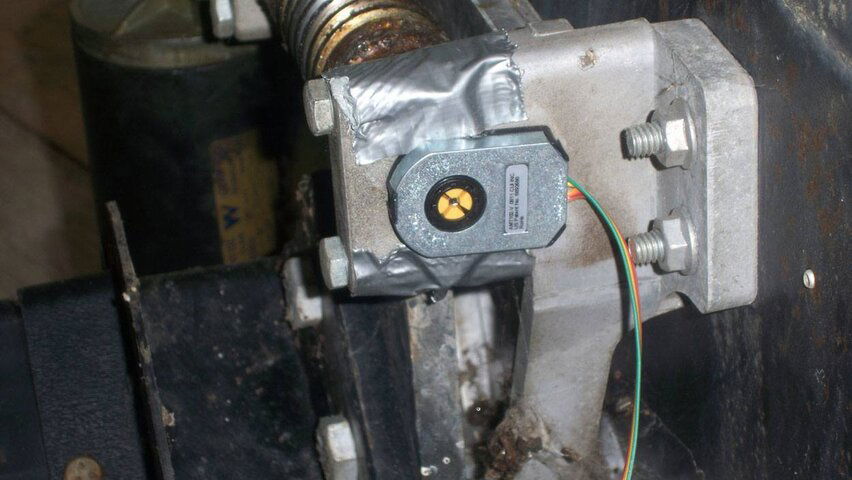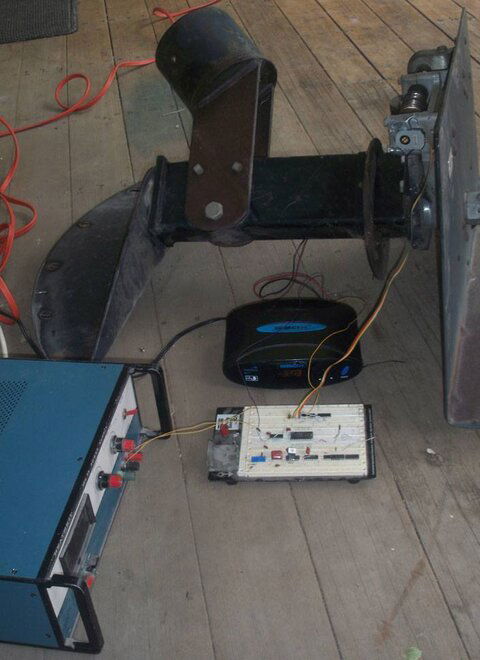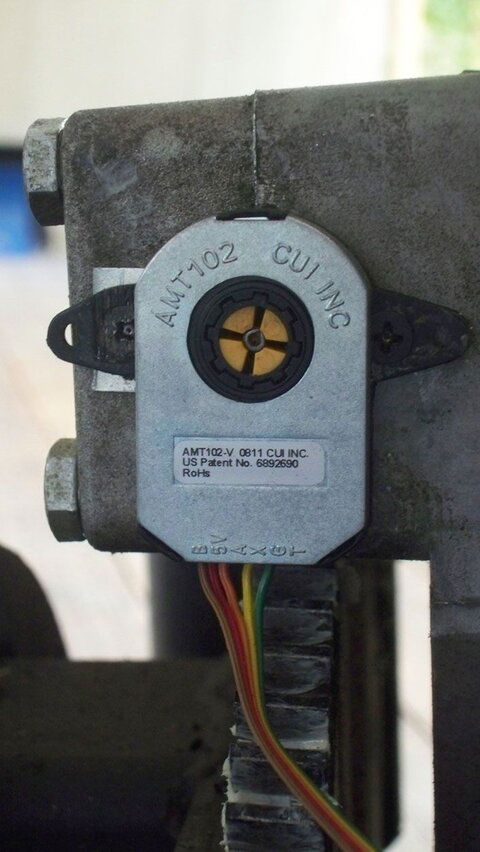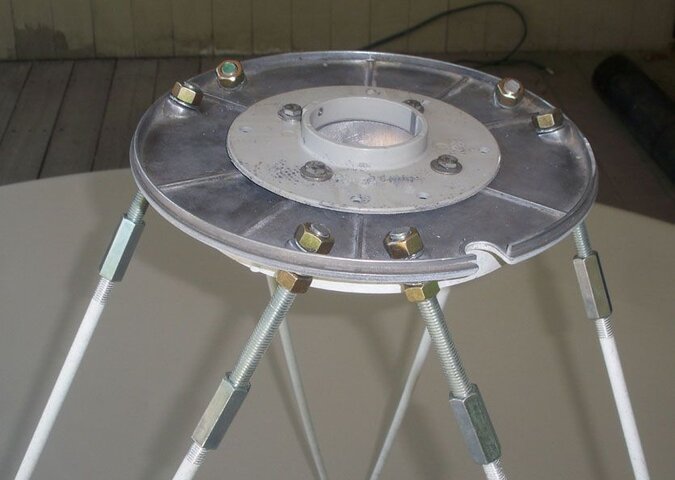A few days ago in another thread several of you offered me great help and advice regarding the potential harvesting a Birdview solid I spotted on Craigslist:
http://www.satelliteguys.us/c-band-satellite-discussion/264089-birdview-motor-pole-questions.html
A friend and I launched the attack on Monday. It was an easy job, other than I forgot to bring wasp spray. Between squirting penetrant on them and swatting with newspapers, we managed to decimate the major part of the town's wasp population without any successful countercharges on us. We lost track of the number of nests we emptied from the motor housing and feed.
Because I had previously decided to mount this to a wall, and because we could see the classic Birdview pole indents below the ground, there seemed no reason to dig out the concrete and thus we chopped the pole at ground level. I plan to follow phlatwound's advice and weld the Birdview tube inside a 6" schedule 40 pipe to extend it to the proper length. The owner probably would have been ok with simply ridding her yard of the dish, but as she was a recent Army wife transplant, I gladly gave her the $75 she asked in the ad. She had been very gracious in answering several rounds of questions, confirming measurements, etc. The dish is in great shape, with only one strut snapped at where it attaches to the dish. More on that later.
The motor housing was a disgusting mess of dead insects and other debris, of which I have only removed the first few layers. I was a little disappointed to find this dish only had the original multi-turn potentiometer position sensing, but having read the extensive threads here on such matters, I had assumed this would have to be dealt with either way.
When I re-read the material, my eye was caught by a post by bryan.lynch several years back:
http://www.satelliteguys.us/124870-birdview-reed-sensor-kit-2.html#post1234794
Bryan found a rotary encoder on the cheap and proposed using this instead of the traditional magnet wheel/reed switch approach. While at that time he planned to do something with this part, as far as I could tell neither he nor anyone else ever reported back about such a scheme. This sounded more fun to me that fabricating a magnet wheel. Yesterday the encoder and some odd parts arrived, and this morning I was a little kid on Christmas.
To summarize, the encoder is an AMT-102 from a company called CUI. It uses capacitive sensing to produce 48-2048 quadrature pulses per revolution. They also make an absolute position encoder which I may investigate some time down the road by attaching it directly to a polar axis shaft. There may be some issues with that, but the possibility of not caring about backlash sounds quite attractive. Still I would probably have to build my own GBOX-like unit to handle such a part. I digress.
The AMT-102 has a DIP switch to adjust the basic pulse rate. As the pulses are provided in quadrature, one can determine the shaft rotation direction. Unfortunately that is of no particular consequence for a GBOX/VBOX. However one can use the quadrature pulses to double the pulses rate. With the GBOX counting on both rising and falling edges, one can obtain 192-8192 pulses per revolution. Before proceeding with the motor itself, I bread-boarded a simple TTL XOR gate connected to an open-collector, high voltage buffer. The outputs of the encoder were wired in and the output connected to a GBOX. When set to the lowest resolution on the DIP switch (48 quadrature pulses), I measured about 200 counts for one turn of the encoder shaft. Perfect.
The next step was to transport the bread-board, power supply and GBOX to close proximity to the Birdview motor housing. The encoder kit has several shaft adapters. I chose the 3mm one which closely matches the worm gear shaft extension on which a small nylon gear used to live. This previously coupled to a larger gear driving the potentiometer. Rather than finalizing the mounting, I simply anchored the main part of the encoder with duct tape. I have attached a couple of photos of the setup.
Everything worked from the get-go. I centered the drive with a precision inclinometer and zeroed the GBOX. I ran motor until the half-moon gear was about to fall off the worm drive. I measured a motor angle of 80 degrees and a GBOX count of 5127, or about 64 clicks per degree (.016 degrees per click). At the same time I verified the GBOX could keep track of counts from -9999 to +9999 (nice). I doubt I would ever run a Birdview +/- 80 degrees because of the load being transferred to one or two teeth on the half-moon gear. This means one could adjust the DIP switch to 100 quadrature pulses per revolution for a resolution of 0.0075 degrees per click with a motor angle range of +/- 75 degrees, and be right at the point of wrapping around the GBOX counter. Of course this all is a bit silly as having such a resolution has very little to do with pointing accuracy. Still, bragging rights are worth something.
The next steps will be to wire-up a permanent circuit with some minor clean-ups and bypass caps, and drill and tap mounting holes for the encoder. First I'll have to clean and grease the gears. I will also have to provide a +5V source to run the circuit. That's available inside the GBOX, and I purchased a connector for the back of the GBOX so I can feed all five leads through that instead of dealing with the cheapo wire clamps on a stock GBOX.
Onto other matters.
I had read several people claiming the Birdview struts place the scalar about an inch too close to the focal point. My rough measurements confirmed that. As one of my struts was already broken, I looked into tapping it at something other than the stock value. It's not perfect, but I decided to tap the ends of all the struts at 7/16-14 after first cutting them down a few inches. I'll then twist on some bolt extenders and use about 4-6" of threaded rod so I can adjust the scalar position over a several inch range. Of course I'll have to drill the scalar plate out for this threading and use two nuts on each strut. This will change the adjustability of the Birdview scalar from being one of the worst imaginable to one of the best.
I've taken measurements of the Birdview scalar and have some minor concerns how well it will match a typical ADL or Chaparral feed. I'm not talking about the internal diameter, which has to be enlarged in any case, but of the field behavior. I may or may not model it before simply going ahead and reaming it out for grins because I don't want to adapt something else at this time.
Those who read my earlier thread may remember one of my targets is 37.5W, which requires a motor angle of 74 degrees where I live. Unfortunately the Birdview's half-moon gear will hit the back plate of the dish at about 65.5 degrees. I could chop out a small piece of this plate as it is not the actual dish surface itself to reach a larger motor angle. As I mentioned earlier, 80 degrees is really the absolute maximum the motor can be driven while still keeping a gear tooth or two meshed with the worm drive gear. If one lets the half-moon fall out of the worm, the pole mount hits at 85 degrees. So there may still be a chance for 37.5W on the Birdview, but I'm not worried either way because my other C-band dishes can steer to about 34W and my 1.8m Prodelin offset on an Ajak mount can barely hit 30W.
More to come as I continue.
http://www.satelliteguys.us/c-band-satellite-discussion/264089-birdview-motor-pole-questions.html
A friend and I launched the attack on Monday. It was an easy job, other than I forgot to bring wasp spray. Between squirting penetrant on them and swatting with newspapers, we managed to decimate the major part of the town's wasp population without any successful countercharges on us. We lost track of the number of nests we emptied from the motor housing and feed.
Because I had previously decided to mount this to a wall, and because we could see the classic Birdview pole indents below the ground, there seemed no reason to dig out the concrete and thus we chopped the pole at ground level. I plan to follow phlatwound's advice and weld the Birdview tube inside a 6" schedule 40 pipe to extend it to the proper length. The owner probably would have been ok with simply ridding her yard of the dish, but as she was a recent Army wife transplant, I gladly gave her the $75 she asked in the ad. She had been very gracious in answering several rounds of questions, confirming measurements, etc. The dish is in great shape, with only one strut snapped at where it attaches to the dish. More on that later.
The motor housing was a disgusting mess of dead insects and other debris, of which I have only removed the first few layers. I was a little disappointed to find this dish only had the original multi-turn potentiometer position sensing, but having read the extensive threads here on such matters, I had assumed this would have to be dealt with either way.
When I re-read the material, my eye was caught by a post by bryan.lynch several years back:
http://www.satelliteguys.us/124870-birdview-reed-sensor-kit-2.html#post1234794
Bryan found a rotary encoder on the cheap and proposed using this instead of the traditional magnet wheel/reed switch approach. While at that time he planned to do something with this part, as far as I could tell neither he nor anyone else ever reported back about such a scheme. This sounded more fun to me that fabricating a magnet wheel. Yesterday the encoder and some odd parts arrived, and this morning I was a little kid on Christmas.
To summarize, the encoder is an AMT-102 from a company called CUI. It uses capacitive sensing to produce 48-2048 quadrature pulses per revolution. They also make an absolute position encoder which I may investigate some time down the road by attaching it directly to a polar axis shaft. There may be some issues with that, but the possibility of not caring about backlash sounds quite attractive. Still I would probably have to build my own GBOX-like unit to handle such a part. I digress.
The AMT-102 has a DIP switch to adjust the basic pulse rate. As the pulses are provided in quadrature, one can determine the shaft rotation direction. Unfortunately that is of no particular consequence for a GBOX/VBOX. However one can use the quadrature pulses to double the pulses rate. With the GBOX counting on both rising and falling edges, one can obtain 192-8192 pulses per revolution. Before proceeding with the motor itself, I bread-boarded a simple TTL XOR gate connected to an open-collector, high voltage buffer. The outputs of the encoder were wired in and the output connected to a GBOX. When set to the lowest resolution on the DIP switch (48 quadrature pulses), I measured about 200 counts for one turn of the encoder shaft. Perfect.
The next step was to transport the bread-board, power supply and GBOX to close proximity to the Birdview motor housing. The encoder kit has several shaft adapters. I chose the 3mm one which closely matches the worm gear shaft extension on which a small nylon gear used to live. This previously coupled to a larger gear driving the potentiometer. Rather than finalizing the mounting, I simply anchored the main part of the encoder with duct tape. I have attached a couple of photos of the setup.
Everything worked from the get-go. I centered the drive with a precision inclinometer and zeroed the GBOX. I ran motor until the half-moon gear was about to fall off the worm drive. I measured a motor angle of 80 degrees and a GBOX count of 5127, or about 64 clicks per degree (.016 degrees per click). At the same time I verified the GBOX could keep track of counts from -9999 to +9999 (nice). I doubt I would ever run a Birdview +/- 80 degrees because of the load being transferred to one or two teeth on the half-moon gear. This means one could adjust the DIP switch to 100 quadrature pulses per revolution for a resolution of 0.0075 degrees per click with a motor angle range of +/- 75 degrees, and be right at the point of wrapping around the GBOX counter. Of course this all is a bit silly as having such a resolution has very little to do with pointing accuracy. Still, bragging rights are worth something.
The next steps will be to wire-up a permanent circuit with some minor clean-ups and bypass caps, and drill and tap mounting holes for the encoder. First I'll have to clean and grease the gears. I will also have to provide a +5V source to run the circuit. That's available inside the GBOX, and I purchased a connector for the back of the GBOX so I can feed all five leads through that instead of dealing with the cheapo wire clamps on a stock GBOX.
Onto other matters.
I had read several people claiming the Birdview struts place the scalar about an inch too close to the focal point. My rough measurements confirmed that. As one of my struts was already broken, I looked into tapping it at something other than the stock value. It's not perfect, but I decided to tap the ends of all the struts at 7/16-14 after first cutting them down a few inches. I'll then twist on some bolt extenders and use about 4-6" of threaded rod so I can adjust the scalar position over a several inch range. Of course I'll have to drill the scalar plate out for this threading and use two nuts on each strut. This will change the adjustability of the Birdview scalar from being one of the worst imaginable to one of the best.
I've taken measurements of the Birdview scalar and have some minor concerns how well it will match a typical ADL or Chaparral feed. I'm not talking about the internal diameter, which has to be enlarged in any case, but of the field behavior. I may or may not model it before simply going ahead and reaming it out for grins because I don't want to adapt something else at this time.
Those who read my earlier thread may remember one of my targets is 37.5W, which requires a motor angle of 74 degrees where I live. Unfortunately the Birdview's half-moon gear will hit the back plate of the dish at about 65.5 degrees. I could chop out a small piece of this plate as it is not the actual dish surface itself to reach a larger motor angle. As I mentioned earlier, 80 degrees is really the absolute maximum the motor can be driven while still keeping a gear tooth or two meshed with the worm drive gear. If one lets the half-moon fall out of the worm, the pole mount hits at 85 degrees. So there may still be a chance for 37.5W on the Birdview, but I'm not worried either way because my other C-band dishes can steer to about 34W and my 1.8m Prodelin offset on an Ajak mount can barely hit 30W.
More to come as I continue.











